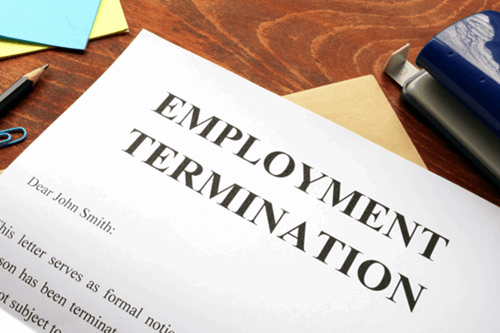Although a natural part of employment, the proper process for terminating an employee’s contract is often awkward and contentious. This can arise in a number of ways. Employees may terminate their contract via resignation, and an employer may terminate the contract by dismissing an employee.
Ensure you comply with UK laws by using this termination of employment letter.
In this article, we will cover what a termination letter is, and how you should be using them in the dismissal process.
If you need immediate assistance, talk to one of the Croner experts here 0800 470 2825.

What is the termination of employment letter UK?
Once you've decided to dismiss an employee, the act must be formally notified. This is regardless of the reason they are being dismissed.
In this case, you will give your employee an employment termination letter, this will include:
- The reason for dismissal.
- The date the employment ends.
- Arrangements about holiday and salary.
- The right to appeal against dismissal.
- Return of the company property and information.
- It also allows for payment in lieu of notice (PILON).
If you don't follow a fair procedure in the dismissal process, you may find yourself at an employment tribunal, and have a costly payout for an unfair dismissal.

When should I send a termination letter?
An employee termination letter will be sent in the final stages of the dismissal procedure. This will outline the reason the employee is being dismissed and how they can appeal the decision. There are five reasons for fair dismissal according to the Employment Rights Act 1996.
Capability.
This is when the employee doesn't have the ability, skills, or qualifications to complete the role they were hired to do.
This can involve disability or illness, regardless of the measures put in place to help them.
Redundancy.
A job role is no longer needed when a company no longer requires it. This can happen when a job or department is closing, or when cutting costs during a crisis.

Statutory Restrictions.
This is where a member of staff is unable to continue working in their position without contravening a statutory restriction.
For example, If an employee works as a driver, they should be able to drive and hold a full driving license.
Some other substantial reason (SOSR).
This term can be vague and broad, but it's essentially a catch-all term. SOSR will apply where an individual's employment can't continue but doesn't for other potentially fair reasons.
Poor conduct.
Conduct is a broad term. This could include
- Gross misconduct.
- Disobeying instructions from management on numerous occasions
- Continually showing poor performance and attendance
- Disclosing private company information
- Theft
- Violence
- Drug abuse in the workplace.
You should ensure that you have a valid reason for dismissing an employee, without a valid reason could lead to an unfair dismissal claim.
You should be able to prove that you acted reasonably in the lead-up to the dismissal to help you avoid an unfair dismissal claim.

Is a termination letter needed to dismiss employees?
When it comes to an employee's dismissal it can be a difficult process, it's incredibly easy to say or do the wrong thing and make the situation worse.
Using a termination of employment letter will help you to ensure that your employee is getting all the right information and that nothing is missing. Dismissal letters will also provide them with the information they need to appeal the decision.
An employment termination letter is needed to provide the reason you are ending your employee's contract, as we've mentioned this formalises the process, and will help prevent wrongful dismissal, discrimination and unfair dismissal claims.
What should I include in my termination letter?
As we've established, the termination letter will formalise the dismissal. you need to ensure you are including correct information in your letter to inform your employees of what is happening and why.
This will include:
The reason
You need to outline the reasons why you are terminating an employee's contract. At this stage, you should be able to provide documentation or a paper trail of proof backing up your reason for the termination.
In this section, you should also outline your decision-making process. Here you can include any incidents of misconduct and disciplinary warnings.
The Dismissal process
This section will outline the process that you followed to reach the decision. Here you should include how you showed fairness towards the decision, by explaining what you did.
This could have been an investigation, hearings, consultation, and the selection process (in the case of redundancy).

Termination date and employee notice period
You should include your employee's last working day in the letter. This will help your internal processes run smoother, with the various teams knowing when the employee's last payday is, and helps them to work out how much holiday pay they are due.
Here you should also state your employee's notice period. This could be either statutory or contractual which is longer. As an employer, you should make it clear whether your employees are needed to work their notice period or not.
Other legal and practical matters
This section could refer to any other matters that need to be made clear during the dismissal.
This can include the return of company equipment and when your employee is likely to receive their P45. You can use this section to remind your employee of any restrictive covenant and clauses in the employment contract that are relevant when they leave.
For example, working for a competitor within a period of time after leaving the business.
The right to appeal.
Your employees have the right to appeal your decision. You should include within the termination letter what the appeal procedure is and how they can follow it.
The employment termination letter will include some basic information such as;


What is the Termination Letter download Format?
After downloading, you’ll have what amounts to termination policy guidelines. The employment contract termination letter format will give you access to:
- A company termination of employment contract letter template you can adapt for your business.
- Termination best practices
- Termination policy checklist to apply to your current process
How to Use This Template
You can download our sample letter to terminate a contract of employment for free as part of our resources.
It’s simply a case of entering a few details and then you’ll have access to the sample letter of termination of an employment contract.
What is Included in This Letter?
This sample letter of early termination of an employment contract should include the following:
- The reason for the termination of the contract
- The effective date of termination
- When they will receive their final paycheck

How Croner Can Help?
Don’t forget, you can get in touch with our team of experts on 0800 470 2825.
Croner has a team of award-winning, HR professionals and consultants who are specialists in their field. We've been helping businesses for over 80 years and our advice line is open 365 days a year, 24 hours a day. Why not speak to a Croner expert on 0800 470 2825
Disclaimer: This template is provided ‘as is’ and Croner Group Ltd excludes all representations, warranties, obligations and liabilities in relation to the template to the maximum extent permitted by law.
Croner Group Ltd is not liable for any errors or omissions in the template and shall not be liable for any loss, injury or damage of any kind caused by its use. Use of the template is entirely at the risk of the User and should you wish to do so then independent legal advice should be sought before use.
Use of the template will be deemed to constitute acceptance of the above terms.
Related resources
Categories
- Business Advice
- Contracts & Documentation
- Culture & Performance
- Disciplinary & Grievances
- Dismissals & Conduct
- Employee Conduct
- Employment Law
- End of Contract
- Equality & Discrimination
- Health & Safety
- Hiring & Managing
- Leave & Absence
- Managing Health & Safety
- Moving
- Occupational Health
- Pay & Benefits
- Recruitment
- Risk & Welfare




